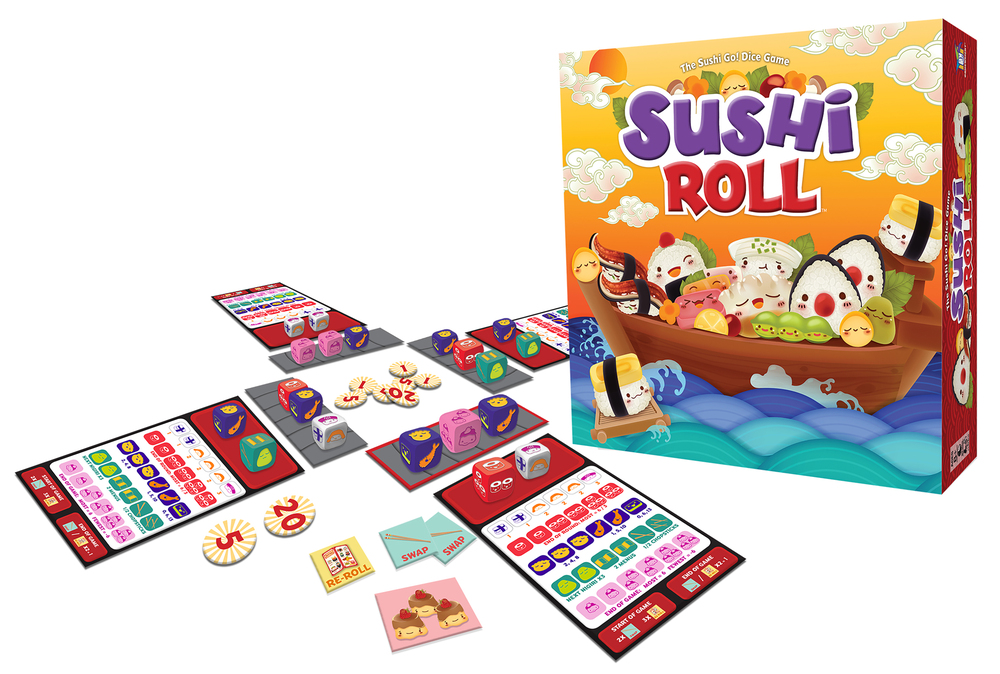Phil Walker-Harding is a mainstay on my year-end board game lists at this point, with Bärenpark (2017) and Gizmos (2018) making my annual top tens the last two years and Silver and Gold obviously set to appear on my list this year. He’s shown himself able to design clever, replayable games across a broad range of mechanics, with Imhotep and Cacao among his other hits and the new Adventure game series (which I have but haven’t tested out yet). He’s also the designer of Sushi Go! and its bigger offshoot Sushi Go Party, one of the best games I know of for 6+ players, and has now added a second brand extension to this title with the … eye roll-inducing title Sushi Roll, a dice-drafting game that captures some of the feel of the original but streamlines it for faster play.
In Sushi Roll, players will roll dice at the start of each round, choosing one die and then passing their ‘conveyor belt’ board with all remaining dice to the left, after which players roll their new dice, choose one, and pass them around. There are five different colors of dice, each of which has a totally different set of images and ways to score: nigiri, worth 1-3 points each; maki, where the player with the most symbols in each round gets six points; tempura, which you collect in sets that can be worth 8-13 points if you get three of a kind; desserts, which score only at game end, six points if you have the most but negative six points if you have the fewest; and green dice that give you extra menu or chopstick tokens, or let you gain wasabi, which can triple the value of a subsequent nigiri die you place on top of the wasabi.

Let me see that Sushi Roll…
The menus and chopsticks give you additional abilities to use on your turns, with each player starting the game with three menu tokens for re-rolls and two chopstick tokens for swaps. You can spend a menu token to re-roll any or all of your dice after your initial roll. You can use a swap token to take one die off of another player’s conveyor belt in exchange for one of yours – one of the only ways that player order, which rotates after each player chooses one die, matters in the game, and the only time you’ll directly interact with another player during game play. (The maki and dessert scoring involves other players, but only at the end of rounds or the end of the game.)
Walker-Harding has definitely hit on the right balance of game length and strategy; there are enough dice in each round, ranging from 16 (two players) to 21 (three players), that you can plan ahead a little bit. You see all of the dice around you, and can at least sort of guess what dice might come your way over the next few turns, so that you can make more informed choices with each draft. Of the five types of dice, only one, the white (nigiri) dice, score immediately with no impact beyond that selection; three of the other dice colors score depending on other dice you collect and possibly what other players get, while the last color, the green dice, offers a little of both. That’s distinct from roll-and-write titles, which are all the rage this year, but which mostly comprise independent rolls and choices.
I’d still put Sushi Go Party! above Sushi Roll, since the former has less randomness and offers more choices within each game and from game to game, while also scaling up to 8 players where Sushi Roll plays 2 to 5. I also don’t think Sushi Roll plays that well with two because it becomes too obvious what dice you might get, and because it’s too easy for the players to take entirely different paths and end up with little to no conflict. (The -6 point penalty for having the fewest dessert icons doesn’t apply in a two-player game.) The two-player mode might benefit from the addition of a dummy player that, say, takes dessert tokens first, then maki tokens, which would directly impact the way the two players score those categories. For 3-5 players who either want a new twist on Sushi Go! or who just love dice games, however, it’s a credible re-imagining of the original that is very true to the earlier games’ mechanics.